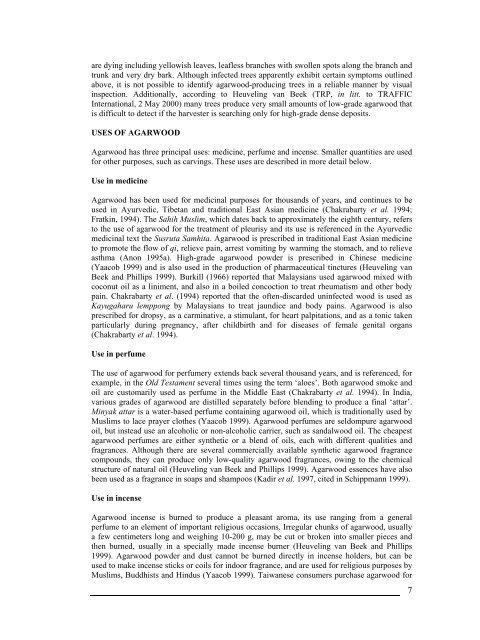Agarwood Plantation at BRAC Tea Estate - BRAC Research and ...
Agarwood Plantation at BRAC Tea Estate - BRAC Research and ...
Agarwood Plantation at BRAC Tea Estate - BRAC Research and ...
You also want an ePaper? Increase the reach of your titles
YUMPU automatically turns print PDFs into web optimized ePapers that Google loves.
are dying including yellowish leaves, leafless branches with swollen spots along the branch <strong>and</strong>trunk <strong>and</strong> very dry bark. Although infected trees apparently exhibit certain symptoms outlinedabove, it is not possible to identify agarwood-producing trees in a reliable manner by visualinspection. Additionally, according to Heuveling van Beek (TRP, in litt. to TRAFFICIntern<strong>at</strong>ional, 2 May 2000) many trees produce very small amounts of low-grade agarwood th<strong>at</strong>is difficult to detect if the harvester is searching only for high-grade dense deposits.USES OF AGARWOOD<strong>Agarwood</strong> has three principal uses: medicine, perfume <strong>and</strong> incense. Smaller quantities are usedfor other purposes, such as carvings. These uses are described in more detail below.Use in medicine<strong>Agarwood</strong> has been used for medicinal purposes for thous<strong>and</strong>s of years, <strong>and</strong> continues to beused in Ayurvedic, Tibetan <strong>and</strong> traditional East Asian medicine (Chakrabarty et al. 1994;Fr<strong>at</strong>kin, 1994). The Sahih Muslim, which d<strong>at</strong>es back to approxim<strong>at</strong>ely the eighth century, refersto the use of agarwood for the tre<strong>at</strong>ment of pleurisy <strong>and</strong> its use is referenced in the Ayurvedicmedicinal text the Susruta Samhita. <strong>Agarwood</strong> is prescribed in traditional East Asian medicineto promote the flow of qi, relieve pain, arrest vomiting by warming the stomach, <strong>and</strong> to relieveasthma (Anon 1995a). High-grade agarwood powder is prescribed in Chinese medicine(Yaacob 1999) <strong>and</strong> is also used in the production of pharmaceutical tinctures (Heuveling vanBeek <strong>and</strong> Phillips 1999). Burkill (1966) reported th<strong>at</strong> Malaysians used agarwood mixed withcoconut oil as a liniment, <strong>and</strong> also in a boiled concoction to tre<strong>at</strong> rheum<strong>at</strong>ism <strong>and</strong> other bodypain. Chakrabarty et al. (1994) reported th<strong>at</strong> the often-discarded uninfected wood is used asKayugaharu lemppong by Malaysians to tre<strong>at</strong> jaundice <strong>and</strong> body pains. <strong>Agarwood</strong> is alsoprescribed for dropsy, as a carmin<strong>at</strong>ive, a stimulant, for heart palpit<strong>at</strong>ions, <strong>and</strong> as a tonic takenparticularly during pregnancy, after childbirth <strong>and</strong> for diseases of female genital organs(Chakrabarty et al. 1994).Use in perfumeThe use of agarwood for perfumery extends back several thous<strong>and</strong> years, <strong>and</strong> is referenced, forexample, in the Old Testament several times using the term ‘aloes’. Both agarwood smoke <strong>and</strong>oil are customarily used as perfume in the Middle East (Chakrabarty et al. 1994). In India,various grades of agarwood are distilled separ<strong>at</strong>ely before blending to produce a final ‘<strong>at</strong>tar’.Minyak <strong>at</strong>tar is a w<strong>at</strong>er-based perfume containing agarwood oil, which is traditionally used byMuslims to lace prayer clothes (Yaacob 1999). <strong>Agarwood</strong> perfumes are seldompure agarwoodoil, but instead use an alcoholic or non-alcoholic carrier, such as s<strong>and</strong>alwood oil. The cheapestagarwood perfumes are either synthetic or a blend of oils, each with different qualities <strong>and</strong>fragrances. Although there are several commercially available synthetic agarwood fragrancecompounds, they can produce only low-quality agarwood fragrances, owing to the chemicalstructure of n<strong>at</strong>ural oil (Heuveling van Beek <strong>and</strong> Phillips 1999). <strong>Agarwood</strong> essences have alsobeen used as a fragrance in soaps <strong>and</strong> shampoos (Kadir et al. 1997, cited in Schippmann 1999).Use in incense<strong>Agarwood</strong> incense is burned to produce a pleasant aroma, its use ranging from a generalperfume to an element of important religious occasions. Irregular chunks of agarwood, usuallya few centimeters long <strong>and</strong> weighing 10-200 g, may be cut or broken into smaller pieces <strong>and</strong>then burned, usually in a specially made incense burner (Heuveling van Beek <strong>and</strong> Phillips1999). <strong>Agarwood</strong> powder <strong>and</strong> dust cannot be burned directly in incense holders, but can beused to make incense sticks or coils for indoor fragrance, <strong>and</strong> are used for religious purposes byMuslims, Buddhists <strong>and</strong> Hindus (Yaacob 1999). Taiwanese consumers purchase agarwood for7















![[re-tender] RFQ for supply of Diesel Generator - Brac](https://img.yumpu.com/44421374/1/186x260/re-tender-rfq-for-supply-of-diesel-generator-brac.jpg?quality=85)
